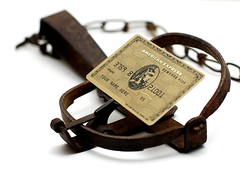Too many people are struggling with debt that should be easy to control. Credit cards make buying things easy, and low payments make us feel like we’ve got full control.

Mike Bitzenhofer via Compfight
Unfortunately, life isn’t always quite that simple. It turns out that minimum payments on credit cards could be the difference between getting out of debt in less than 3 years or having it linger as long as 9 years… and that’s if you never purchase another thing. It’s something most people don’t even think about; that’s we’re here to alert you.
If you’re in the mindset where you’re looking for solutions because you’ve finally realized you have some issue with credit card debt, this post is here to help.
The first tip, is to learn how credit cards work. You know you can hand someone a credit card and, as long as you’re not over your maximum balance, you can buy whatever you want. What most people don’t understand is that if they don’t pay the balance off monthly interest increases how much is owed every month.
The second tip is to immediately stop using your credit cards until you can figure out your debt. You figure out your debt by looking at all of your balances, looking at your interest rate, then seeing how much you owe monthly. I’m going to give you an easy way to make an estimate but if you want something a bit more in depth check out this post.
If your balance is $500 or less, look at how much your monthly payment is. Take $5 off that amount, then multiply that figure by 12. Subtract that total from your balance. Then take another $5 off your previous payment amount and multiply that by 12, and subtract that amount from your balance. If you’re at a negative balance, but barely, it means it’ll take you between 18 and 24 months to pay off your balance if you don’t use your card again and only pay the minimum balance.
If your balance is between $501 and $1,500, do the same thing, only in $10 increments every 12 months until you’re down to between $15 and $20. Yes, that’s right; it’s going to take you 5 years or so to pay off that balance if you never use that card again.
If it’s higher than $1,500,… well, just realize it’s going to take you more than 5 years and run with that for now.
Number three, call each of your credit card companies to see if you can get a reduction on the interest rate. If you can, great. If not, you at least now get to request a free credit report from all 3 agencies, because they have to give you an official reason why you didn’t qualify.
That’s important because, even though you’re allowed a free one once a year, it’s nice being able to get another one for free and space out what you’re seeing as it involves the reporting of your outstanding debt, as well as a host of other things.
Number four, start paying off your cards, but get rid of one as fast as you can. There are different rules of thought on this subject, but we’ll share this one.
If you can get one card paid off, you’ll feel a sense of accomplishment and see the plan works. Concentrate on the card you can actually pay off the quickest, and pay more than what’s due only on that card. Doesn’t matter how much it is, just pay more than the minimum.
When that card is paid, take that payment and add it to the next card, and so on. If you have only three cards, pay in the order you can get rid of them. If you have more, start with the lowest two, then go after the one with the highest interest rate, not the highest balance. You actually will bring your debt down quicker because that high interest rate is kicking your behind, but now you have extra funds to throw at it, so it’ll come down quickly.
There you are; it’s not a lot, but these are some valid solutions on how to bring down your credit card debt. It’s not hard but it takes diligence to get it done. Good luck.


